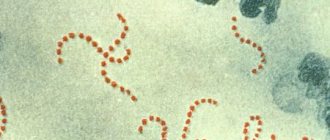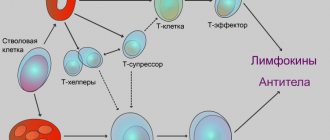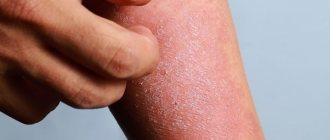Professions - risk groups
This disease mainly affects medical workers, mechanics, builders, hairdressers, cosmetologists, makeup artists, cleaners, gardeners, agricultural workers, as well as people who work with food (waiters, cooks, etc.).
- The most common irritating agents are solvents, bleaches, medical alcohol, soaps, deodorants, cosmetics, sawdust, oils, and detergents.
- If you have to wash your hands regularly or the work itself involves the fact that they are often in a humid environment, then this is also a risk factor for the development of contact dermatitis.
- Allergic contact dermatitis can be caused by metals, formaldehyde (found in glue, solvents), plants, cosmetics, etc.
Manifestations and types of contact dermatitis
For irritant contact dermatitis to occur, a single exposure to the agent may be sufficient. Then the disease is called acute , redness of the skin occurs, often swelling, blisters, and the affected area becomes moist. All this is accompanied by burning, pain and often itching.
Chronic is more common - when there is prolonged contact with a substance that has a mild irritant effect. Then the skin becomes dry, red, flaky, thicker and cracks.
With irritant contact dermatitis, problems most often occur on the back of the hand and the skin between the fingers. But sometimes even areas covered by clothing, such as the genitals, are affected.
With allergic contact dermatitis, the boundaries of redness can be blurred, several areas are affected at once: eyelids, lips, etc. Pain and burning occur infrequently, but there is almost always itching. Visually, allergic and irritant contact dermatitis are quite similar.
If you suspect contact dermatitis, your doctor will first ask you about the specifics of your work (especially if you are undergoing a medical examination), as well as when your symptoms began and what you attribute to their worsening. Therefore, it is better to prepare and try to answer these questions for yourself before visiting the doctor. The doctor will also be interested in whether you have already had dermatitis and allergic diseases.
Reasons for development
Childhood atopic dermatitis is a public health problem in developed countries and has a prevalence of 10 to 20%. Within the same country, rates are higher in urban areas and among populations with higher standards of living. With age, the prevalence and intensity of the disease decrease. 60% of patients are diagnosed in the first year of life, mainly in the first six months, in 85% in the first 5 years and only in 10% after 7 years.
In 70-80% of patients it develops against the background of a hereditary predisposition. The genetic basis is combined with various immunological changes in the skin, which cause dysfunction of the protective barrier:
- mutations lead to the appearance of microcracks, transepidermal loss of moisture and pH imbalance;
- this facilitates the entry of environmental irritants, allergens (mites, food, pollen) that increase sensitivity, and pathogens such as Staphylococcus aureus.
These factors lead to cellular infiltration of the dermis and constant inflammation with an initial imbalance of lymphocytes that produce Ig E upon contact with allergens. Subclinical inflammation persists even beyond exacerbation
Main causes of the disease:
- Excessive dryness. Patients have a defect that prevents the skin from moisturizing. The situation is especially worse in winter due to the use of heaters and reduced indoor humidity. Frequent washing without subsequent moisturizing also dries.
- Stimulus. Various household chemicals and low-quality care products can cause burning, redness, itching or dryness.
- Emotional stress. Sheer disappointment, fear and anger are provocateurs to which the child’s skin reacts with itching and redness.
- Excessive sweating. If clothing is not appropriate for the weather, the skin performs the function of thermoregulation - it sweats, which leads to a worsening of the clinical picture.
Separately, infection with staphylococcus should be considered. In this case, outlined areas or vesicles with pus appear. The disease can be caused by herpes and fungus. In rare cases, pollen, dust mites and pets cause atopic dermatitis in very young children.
How is the diagnosis made?
To rule out or confirm allergic contact dermatitis, your doctor will perform a skin test. It consists of applying samples of common common allergens and those found in your workplace to the skin. If redness and inflammation occur, then there is an allergy to the applied substance.
In rare cases, a biopsy (analysis of a tissue sample) of the skin is required to rule out other diseases (psoriasis or other inflammatory dermatoses).
If the diagnosis of irritant contact dermatitis is confirmed, then treatment will have three directions:
- Avoid exposure to irritant.
- Restore damaged skin.
- Relieve inflammation.
If contact with an irritating substance cannot be excluded, then you can wear a respirator, goggles, overalls or, for example, latex gloves with an inner cotton layer. This is necessary so that sweat is absorbed by the fabric and does not harm the skin.
Prevention of psoriasis on the hands
Prevention of the disease includes patient compliance with recommendations on daily routine, skin care and nutrition.
Psoriasis on the hands is best treated in the early stages of the pathological process. It is impossible to completely cure this process, since under the influence of any factors a relapse may begin. But if maintenance treatment is carried out periodically, remission for a long time is quite possible. At the same time, the person lives life to the fullest and does not remember relapses.
What can you do yourself?
To restore damaged hand skin, you need to follow a number of simple rules:
- wear gloves in cold weather;
- Use warm water and a little mild detergent to wash your hands;
- rinse off the soap well and dry your hands;
- often (at least every time after washing your hands) use moisturizing and skin softening products, as well as those that prevent skin dehydration. These are usually creams with petroleum jelly, lanolin, glycerin, ceramides, dimethicone, propylene glycol, urea, etc.
It is recommended to relieve inflammation with the help of corticosteroids (in the form of cream, lotion, foam or, better yet, ointment). If the dermatitis is severe or chronic, with noticeable thickening of the skin and is not on the face or in the area of skin folds, then clobetasol, diflucortolone, etc. are used for 2-4 weeks. In less severe cases, betamethasone, diflucortolone, mometasone, triamcinolone, etc. are used (also for 2–4 weeks). When dermatitis is on the face or in the area of skin folds, weaker corticosteroids or corticosteroids in lower dosages are used: triamcinolone, betamethasone, hydrocortisone, etc. for 1–2 weeks.
It is highly advisable not to scratch the sore spot, otherwise additional damage to the skin may create a suitable environment for bacterial infection.
After a case of acute dermatitis, recovery takes about a month if there is no further exposure to the irritating agent. With chronic contact dermatitis, symptoms may not go away for months or years.
For allergic contact dermatitis, the most important thing is to avoid the substance that caused the disease and relieve inflammation. The methods are approximately the same: wear gloves, overalls, a mask and goggles, use corticosteroids for 1-2 weeks (in severe cases it is better to take systemic drugs, that is, in tablets) or calcineurin inhibitors (for example, pimecrolimus cream).
Treatment
Therapy for children and adults is individual. Treatment is based on the collected data - age, time and causes of relapses, forms of manifestations, concomitant diseases, the degree of activity of the process at the time of contacting the doctor, the presence of complications.
Treatment of atopic dermatitis is carried out in parallel in several directions:
- general drug treatment;
- diet development;
- anti-inflammatory therapy with external agents;
- elimination of factors that provoke relapses, according to the doctor’s recommendations;
- climatotherapy;
- properly selected cosmetic care without dyes and fragrances.
GCS is used as external therapy - this is the first thing prescribed to the patient. When prescribing, doctors must clearly prescribe the dosage, treatment plan and timing, take into account contraindications, and choose the best progressive drugs.
Antihistamines are used as the basis of general drug treatment. Treatment of atopic dermatitis is carried out in different ways depending on what phase the patient is in - acute or chronic. Treatment for adults differs from treatment for infants and children.
During the acute phase, the following are used:
- 2nd generation antihistamines for 4-6 weeks;
- local lotions - oak bark tincture, tannin solution, rivanol solution, if there is exudation, dyes, for example, fucorcin and Castelani liquid);
- external glucocorticosteroids for 3-7 days;
- systemic corticosteroids (if therapy does not produce the expected results).
Chronic phase:
- 2nd generation antihistamines for 3-4 months;
- external corticosteroids;
- combination corticosteroids;
- immunosuppressive drugs;
- polyunsaturated fatty acids.
Additives in antihistamines can cause exacerbation, so the doctor should monitor the progress of treatment and promptly change the drug to another one that has other side additives.
After treatment has given results, it is important to carry out prevention to prevent the development of a new exacerbation. For this purpose, 3rd generation antihistamines are used, which are taken for 6 months (therapy can be extended), polyunsaturated fatty acids, immunomodulators and specific immunotherapy.
The use of first-generation drugs is currently not widespread, since they penetrate the blood-brain barrier, cause many side effects, reduce performance, tachyphylaxis, and dry mucous membranes.
Dangerous symptoms of dermatitis
If you have signs of contact dermatitis, consult your doctor. The doctor will make a diagnosis and prescribe treatment that will alleviate your condition. You should not hesitate if, along with redness on the skin, signs of infection appear (pus, fever), or if you feel that the mucous membranes of the respiratory tract (it hurts to breathe) or the gastrointestinal tract (it hurts to chew and swallow) are damaged.
To diagnose and treat contact dermatitis, make an appointment with a dermatologist - call +7 (495) 120-08-07.
Diagnostics
Treatment of skin diseases always begins with differential diagnosis. There are basic criteria on the basis of which a diagnosis is made.
Diagnosis is carried out by an allergist or dermatologist. To suggest a diagnosis by visual examination, it is enough to observe three main and three additional criteria in the patient (these are symptoms that are divided into 2 such groups.).
Among the main criteria:
- itching;
- type of skin manifestations;
- the presence of any atopic or allergic disease in the family;
- wave-like course of the disease “exacerbation - relapse”.
There are much more additional or so-called minor criteria; we partially named them in the “Symptoms” section.
In addition to them, we can indicate:
- the appearance of the first symptoms before the age of 2 years;
- increased levels of total and specific IgE antibodies;
- white or mixed dermographism;
- the presence of a Denny-Morgan line (longitudinal fold under the eye);
- keratoconus.
In NEARMEDIC clinics you can undergo a full examination. It is not necessary to use all of the diagnostic techniques listed below; the doctor will prescribe the necessary ones individually, depending on the results of the examination and medical history.
- A blood test can also reveal eosinophilia as a nonspecific sign.
- Determination of allergen-specific IgE in the blood and skin tests allow one to assess the presence of food allergies (a negative result is useful for diagnosing atopic dermatitis; it allows one to exclude food allergies from the mechanism of the disease).
- A general analysis of the amount of IgE - a large amount in the blood may indicate dermatitis, but a low level cannot refute it with 100% probability.








